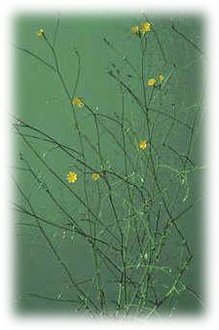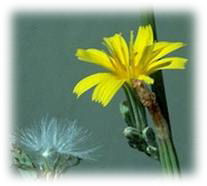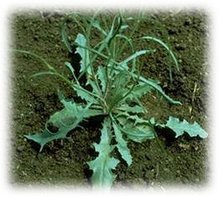Most Wanted Noxious Weed "Rush Skeleton Weed"

Description and VariationDescription and Variation: Rush skeletonweed belongs to the chicory tribe of the sunflower family. This herbaceous perennial ranges from one to four feet tall, with a taproot reaching down seven feet, or more. The seedlings have a long thin taproot. Rush skeletonweed overwinters as a rosette of hairless, basal leaves that are two to five inches long and ½ to 2 inches wide and broader at the tip. The lateral lobes point back toward the base - very similar to a dandelion. The mature plant consists of a dark green, nearly leafless flowering stem, with many aerial branches. The basal rosette is absent at this stage. The stem and aerial branches support a few leaves, which are narrow and linear, and mostly entire. A distinguishing characteristic of rush skeletonweed is the presence of coarse, downward pointing brown hairs near the base of the stem. The stems and roots of rush skeletonweed exude a white latex sap when cut. The flower heads, about ½ inch in diameter, grow along the stem in the leaf axil or at the branch tips, and they are found individually or in clusters of twi to five. Each flower head has 7-15 (usually 11) ray flowers, with yellow ligules resembling petals. These yellow ligules are strap shaped with small teeth across the blunt end. Mature, vigorous plants can produce 1,500 flower heads, with the capability of producing 20,000 seeds. The immature seeds are greenish-white, and they gradually darken to a yellow-brown or olive-green in the 13-15 days it takes to mature. The seed color can be used as an indication of maturity, with light colored seeds showing low germination rates (Old 1981). Each seed has a pappus, which is capable of carrying seeds along wind currents up to 20 miles (Cuthbertson 1967 and Schirman and Robocker 1967 as cited in McLellan 1991).

Detrimental: Rush skeletonweed is a threat to irrigated lands of the Columbia Basin, to the sandy soils of dry land wheat areas (Old 1981), and it is a threat to rangelands. Rangeland infestations impact the cattle industry when rush skeletonweed displaces native or beneficial forage species grazed by livestock and wildlife. Forage production is lowered when rush skeletonweed successfully outcompetes beneficial species for limited resources, particularly nitrogen. Often, the cost of herbicide control is not economical due to low productivity of the land (Sheley).

Rush skeletonweed spreads from rangeland to croplands by seed. Once established on roadsides adjacent to croplands, mechanical injury to the plant can produce shoots from any part of the main root, from the lateral roots, and from root fragments at least 4 feet deep (Old 1981). Once established in wheat-fallow systems, cultivation is the major factor of spread. Crop yields are also reduced as a result of rush skeleton-weed outcompeting grain for soil moisture and nitrogen. Grain harvest is difficult because of the wiry stems, and the latex sap of rush skeletonweed gums up harvesting machinery. In Australia, crop yields were reduced by 50-70 percent, with some fields later converted to rangeland.
Contact Information
Umatilla County Road Department
3920 Westgate Street
Pendleton, Or 97801
Info:541-278-5462
The Weed Department is open 6:30 am. to 5 pm. Mon. through Thr.

